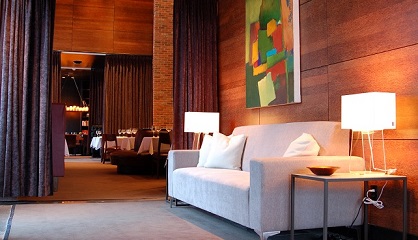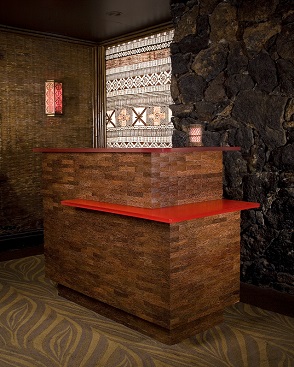
NATIONAL REPORT—The use of exotic hardwoods for high-end hospitality interiors is well established; the deep, warm radiance of these woods creates a cozy, intimate environment for hotel lobbies, day spas and restaurants. However, over the past few decades the industry has become more aware of the damaging effects unsustainable tropical forest harvests have on our environment and thus the need for sustainable, yet attractive alternatives.
As this awareness and knowledge that sustainability in all things is the way forward, architects and hospitality designers have embraced both the beauty and utility of such innovative alternatives as bamboo, cork, rubberwood (Hevea) and a wide range of interior products based on high-recycle content.
Another exciting and sustainable interiors material that is gaining popularity is palm wood. This hard, dark wood is derived from the stems of mature palm trees throughout the tropical zone. It is estimated that there is enough mature palm wood globally to support large and small industry in the production of everything from basic lumber and door core to high quality paneling, flooring, veneer and architectural grade plywood for store fixtures and cabinetry.
Similar to Bamboo
Both palm and the wood derived from it are unique in the interior materials market and are more similar in fiber assembly to bamboo than to a conventional tree species. Where a tree develops annual growth rings and has branches that create knots or additional grain patterns in the wood, palm has no branches or annual growth rings. In this way the grain and texture of palm is strikingly different, yet still very wood-like. Whereas a tree is typically hardest at the core and softest at the outside edge, palm is the opposite, with a soft, punky core and a very hard, dense perimeter wall.
Palm rendering techniques are also different from wood and therefore much work and time has been dedicated to understanding the most efficient approach to extracting the best wood from the palm stem. Additionally, soil conditions and mineral content can sometime drive color in palm wood, creating a wide range of color from a salmon pink to a rich dark mahogany or ebony.
The source of palm tree stems is typically from plantation or agricultural settings and the palms are taken down and sold off after their productive life span of 60 to 80 years. These lands can then be replanted with palms that will begin to bear fruit or nuts in 12 to 15 years, depending on species and climate. In this way, the lumber provides a byproduct to the primary agricultural end-use, along with additional income to the farmer and support for a local cottage industry as well.
Palm as a material for fabrication in western design is not a new idea. During the Paris Art Deco movement of the 1920s, palmwood was embraced by many interior and furniture designers, including Eugene Printz, 1889 to 1948. Many of his palm pieces are still highly sought-after, fetching prices in the medium six figures to some pieces selling for in excess of $1 million.

Installation Examples
Sustainable architectural products manufacturer Smith & Fong Co. has been a pioneer in the development of palmwood finishes, particularly panels and flooring. The company focuses primarily on commercial and hospitality interiors. Exotic, sustainable materials have always been a passion for Smith & Fong, and after establishing itself in the bamboo world with Plyboo, the company introduced palm under the Durapalm brand. Initial explorations began in 2000, and shortly after that Smith & Fong brought to market its first offerings in palm flooring and panel goods, both of which have found their way into restaurant and hotel environments throughout North America and globally. Following are three interesting applications.
Tucked inside Three Dots And A Dash, a Chicago based restaurant and bar, the Bamboo Room is a Polynesian-inspired tiki bar replete with wall carvings, tropical kitsch and exotic drink concoctions. Interior designers were looking for an exotic material to decorate the bar front. They wanted something that was both refined but still retained a bit of that hand-carved feel. Smith & Fong’s Durapalm Malabar panel was both easy to work with and easy to install. Concealed lighting was placed underneath the bar top to give the surface of the Malabar more depth and to make it stand out as a design element.
Loft 610 Urban Restaurant & Lounge seeks to fill a dining and entertainment void for Texans who have left urban areas of major cities for the quality of life found in suburbs such as Plano, Frisco and McKinney. The owner of the restaurant, Twomey Concepts, asserts, “Moving to the suburbs does not mean that you lose your need for an upscale, urban vibe, but consumers often must settle for a less-fulfilling option that is closer to home—we want to change that. We wanted the space to feel like an old brick warehouse that was repurposed into a modern restaurant.” Loft 610 accomplished that goal by featuring walls of reclaimed brick and palm plywood panels, exposed steel structures and polished concrete floors.
The design of Perky’s Café, located in Jamestown, N.C., comprises the use and application of both Durapalm and Plyboo architectural plywood. For the wall-mounted shelving units, linear grain palm plywood was employed. The design approach was clean and straightforward, letting the linear orientation of the material and warmth of the natural palm speak for itself. In keeping with the color and tone of the design and capturing every bit of utility from the material, the palm round cuts from the wine rack construction were reused as coasters for drink service. Perky’s Café is a clean, smart execution of design and function.
Palm wood offers a sustainable and exciting alternative to rain forest hardwoods as well as exciting new colors, textures, and applications for the hospitality design community.
Dan Smith is the founder and CEO, Smith & Fong Co.





